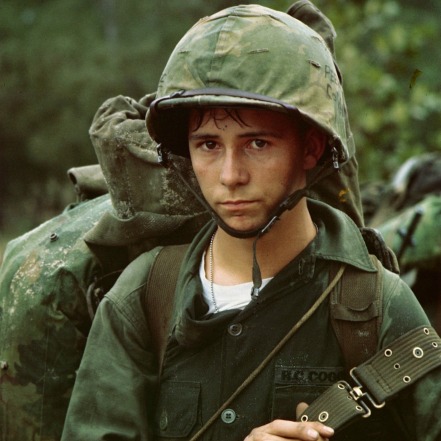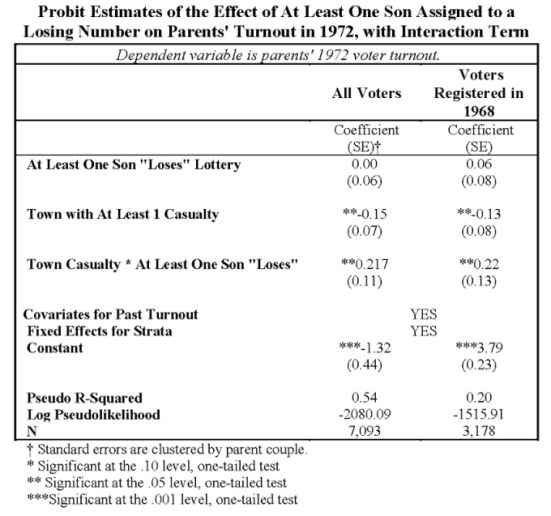
The following is part of a series of posts written by 2016 MPSA award recipients highlighting outstanding research presented at previous MPSA annual conferences.
How do citizens respond to government policies that impose a significant burden? Perhaps the most onerous of all public policies are those related to military conscription. Amid waning public support for the Vietnam War and growing distrust around the administration of the Selective Service System, American military conscription came to an end in 1973. As the Vietnam War drew to a close, fewer and fewer men were being drafted. Many sought a more egalitarian way to determine which men were compelled to serve. After a long political and legislative battle, Congress returned authority to the executive branch to determine the order of induction by random lottery. In November of 1969, President Richard Nixon issued the executive order to reinstate the draft lottery system to determine the order of induction priority among American men.
On December 1, 1969, the first of the three consequential lotteries of the Vietnam era was held. The 366 possible birthdays in a leap year were printed on strips of paper and placed in blue capsules. The capsules were drawn from a glass cylinder in an event that was broadcast on national television and radio; the resulting order of priority was printed in every newspaper. Each birthday was assigned a Random Sequence Number based on the order in which it was drawn. In the 1969 lottery, the first birthday drawn was September 14. Men born on that day were assigned a Random Sequence Number of “1”; they were first in line to be drafted for service unless they had deferments or were otherwise unqualified. Men with lower numbers, therefore, were assigned a higher risk of being drafted. Numbers up to a particular “ceiling” – 125 for men in the 1969 lottery – were called in numerical order to appear before their local draft boards.
The Vietnam draft lotteries provide a “natural experiment” that has been used to study causal relationships between conscription, service, or combat on a variety of outcomes across a wide range of disciplines. I use the draft lottery design to measure the causal effect of government-induced risk of loss on voter turnout. Since risk of military service was randomly assigned by the lottery, the study avoids the endogeneity issues that arise as a consequence of the fact that the attributes that make one likely to serve in the military are correlated with the attributes that make one likely to vote.
The draft lotteries created “winners” and “losers.” Unlike other lotteries, however, “losing” the draft lottery could result in catastrophic loss for men and their families. How did such exposure to such an extreme policy affect political participation? Specifically, I ask the following questions: First, were the parents of men assigned low numbers that incurred a greater risk of being drafted more likely to vote in the 1972 presidential election than parents of men whose sons permanently escaped the draft with high lottery numbers? Second, did the effects of randomly assigned draft risk vary across local contexts? In particular, was the effect on voter turnout stronger when the risk of loss was made salient by previous local casualties?
For this study, I assembled a dataset of parents of men born in 1950-1952 – the years for which the lottery was the exclusive mechanism for determining induction priority – from births recorded in the annual reports of small towns in New Hampshire. To measure responsive participation, I used voter checklists used at polling places, copies of which are held in the from the New Hampshire State Archives to record individual-level turnout of the men’s parents in the 1972 election.
Results of my analysis imply that parents of men assigned to low numbers turned out, on average, at a rate between 2.5 and 4.5 percentage points higher than parents of men who were safe from the draft. Risk of catastrophic policy-induced loss appears to have motivated responsive political participation among those most likely to be negatively affected. This finding conforms to expectations formed on the basis of prospect theory, which is motivated by the observation that people are more sensitive to potential losses than potential gains.
Were parents from towns with prior “hometown” casualties more strongly affected by their son being assigned a “losing” or risky lottery number? Using casualty data from the National Archives, I created a binary indicator for whether or not a town had experienced a local casualty in the Vietnam War prior to the first lottery drawing on December 1, 1969. Probit estimates reported in the table below imply that the effects of conscription risk on parents’ turnout were heterogeneous across local contexts. Parents from towns with prior casualties whose sons were assigned risky numbers voted at a rate approximately nine percentage points higher than parents of men assigned safe numbers in those towns. The effect of a losing number on voter turnout of parents from towns without prior casualties was two percentage points and was not statistically significant.

There are several implications of the study. First, the findings complement recent reconsiderations of the political consequences of the Vietnam draft by contribute behavioral evidence that self-interest manifests itself in responsive political participation. Second, the heterogeneous treatment effects imply that context, in this case local war casualties, moderates the ways in which people experience policies and consequently, the way they respond to them. Third, the analysis offers evidence that voters are more likely to be mobilized by potential loss than potential gains, since the “losing” parents voted at higher rates than the “winning” parents. Local casualties may have intensified perceptions of the risk incurred by a “losing” number. A socially proximate casualty may have functioned as a sort of “availability heuristic,” leading parents of men assigned numbers that exposed their sons to greater risk of conscription to overestimate the probability of casualties among draftees. Finally, the differential rates of turnout between parents who were more and less affected by draft policies constitute evidence of mass policy feedback. Though we cannot know which candidate parents mobilized by exposure to draft risk supported, we know they participated at higher rates in response to draft policy.
 About the Author: Tiffany C. Davenport is an Assistant Professor, Department of Political Science United States Naval Academy. Davenport’s article, “Policy-Induced Risk and Responsive Participation: The Effect of a Son’s Conscription Risk on the Voting Behavior of His Parents”, published in the January 2015 issue of the American Journal of Political Science, was awarded the AJPS Best Article Award at the 2016 MPSA Conference. (MPSA members: Log in at http://www.mpsanet.org/AJPS to access.)
About the Author: Tiffany C. Davenport is an Assistant Professor, Department of Political Science United States Naval Academy. Davenport’s article, “Policy-Induced Risk and Responsive Participation: The Effect of a Son’s Conscription Risk on the Voting Behavior of His Parents”, published in the January 2015 issue of the American Journal of Political Science, was awarded the AJPS Best Article Award at the 2016 MPSA Conference. (MPSA members: Log in at http://www.mpsanet.org/AJPS to access.)
